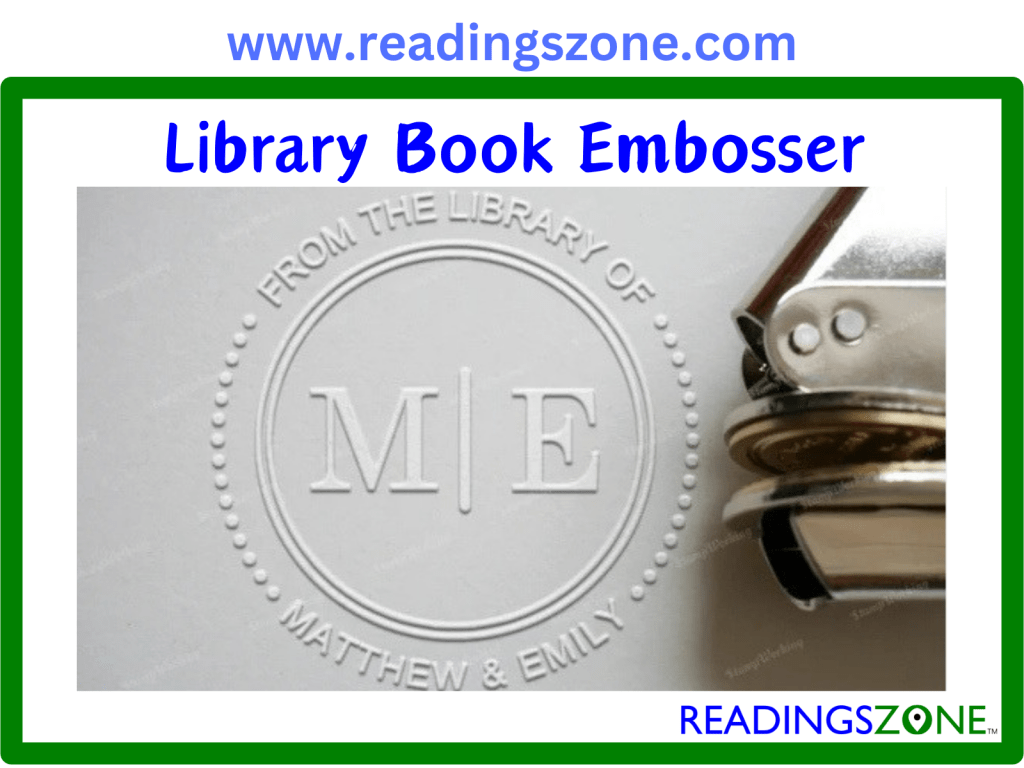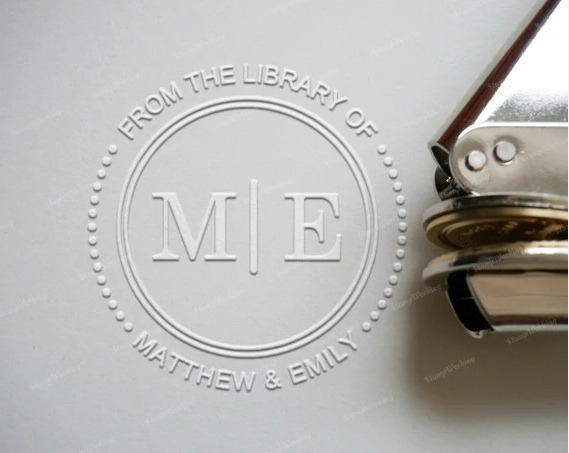Book embosser: A short but complete guide[2025]!

Table of Contents
ToggleHave you ever wanted your words and pictures to jump off the page? Embossing is a really cool trick that people have enjoyed for hundreds of years! This incredible technique makes paper feel 3D and raised. You can see the design and actually feel it with your fingertips.For any true book lover, a book embosser is a magical tool that turns a simple page into a beautiful, textured work of art.
But here’s a fun twist: this isn’t only for books! Using raised stamps is an age-old technique found across the globe. From 1847 to 1854, sending mail in Europe was an entirely different experience. Many people loved using special stamped envelopes or letter sheets with unique designs. It made every piece of mail feel more official and exciting. Actually, these classical techniques of art ,you can easily think it nowadays also.
You may also be interested to know the comprehensive guide on book binding
Amazing reference Book on Book embossers!
Mary Jane Miller and Valentin Gomez’s famous book “Embossing Metal: Templates and Beginner Techniques: Hand-Tooled Pewter Repousee Halos for Saints and Iconography” is about the art of embossing.
It is a complete guide on how to emboss in a more customized way. Here, master iconographer Mary Jane Miller illustrated 1600 years of dating back to embossing techniques. The manual is straightforward and clear. The patterns, as she points out here, are simply applicable.
A custom book embosser works two ways by using two dies-1. raised and 2. recessed way. A raised die forces the paper or book’s page and recess to leave an embossed impression.
Usually, we have seen 12 rectangular,1/3/4, and 1/5/8 inch sizes embossers. Mostly, the seal is available with materials of metallic bronze, metallic silver, metallic gold, or metallic green, red, or blue. A larger die indicates better embossing.
How embosser machine work?
Usually, according to the squeezed fibers of the paper, a specific level of pressure is applied. It creates a permanent sign. After producing dies, a die maker engraves the desired image into metal plates.
A personalized book embosser creates a high-quality textural contrast to the surrounding part of the paper stock.
Debossing, on the other hand, recesses the design opposite to raising it. A book stamp embosser creates a distinctive effect. The full embossing process and types of die fall into three factors.-
- 1. Pressure; the intensity of the impact on the weight.
- 2. Heat; maintaining a consistent heat level to leave the best impression.
- 3. Die depth; To achieve the perfect artwork in the book one needs to retool the die.
The manufacturing process of book embossing: A simple understanding
Embossing a book results in the creation of raised images on the cover or pages. This gives it a unique look and feel. It’s easy to understand how it’s done:
1.Making the design: The first thing that needs to be done is making the design that will be stamped. It could be anything from simple words to complicated patterns. A graphic artist makes it most of the time.
2.Making the Embossing Plate: The image is put on a metal plate once it is ready. This plate was made specially so that the parts of the image that need to be raised are higher up on the plate.
3.Getting the Book Cover or Page Ready: The part of the book that will be embossed is now ready. This is normally the cover or a special page. That means it has to be made of something that can be shaped with force, like thick paper or leather.
4.The stamping process: A machine is then used to press the plate onto the book cover or page. A lot of pressure is put on this machine, which pushes the raised parts of the plate into the material to make the image.
5.Finishing Touches: Once the book has been embossed, it may be painted or have other decorations added around the stamped area to make it look better.
6.Quality Check: Finally, the quality of the embossed book is checked to make sure the image is clear and in the right shape.
This process gives the book a tactile and visual element that makes it more appealing and sometimes easier to find. This is especially true for books that need to stand out, like limited copies or high-end publications.
An alternative short technique way of the process

Pic credit: Shutterstock
The desired electronic image file is sent to a laser. It engraves a positive and negative die. Their un-embossed part of the image vanishes away leaving the black part of the image raised on the positive die. Negative die, on the other hand, after being lasered the raised part or black part is burned away to leave the image as an impression on the die.
How many types of embossed seals?
There are many different styles of book embossing, ranging from simple letterpress to more sophisticated digital methods. However, some common elements apply to all of them.
In general, there are two main types of embossing:
a.Dry embossing’
b.Heat embossing
Dry embossing indicates simply pressing a design to a certain book, card, etc.
But heat embossing covers the usage of stamps, inks, and heat guns at the same time.
In general, embossing can be three different types-
1. Blind embossing: It refers to embossing the book with an image without color.
2. Colour register embossing: It refers to embossing with ink, foil, punching, or with a second embossed image.
3. Combo stamping: It is the process of embossing and foil stamping the same image. Usually, the sculptured die comes with cutting-edge technology.
Based on those types, the following book embossers are common in the market.
1. Handheld Embossers: This embosser is small and easy to carry. You can put a pattern on your books with them. They’re suitable for people who want to make their books more unique.
2. Desktop Embossers: This type of embosser is a bit bigger and stays on a desk. These can be used more often and are better than handheld ones. They’re great for people who need to mark up a lot of books.
3. Electric Embossers: Electricity drives these, and they do the work for you. They work great when you need to mark up a lot of books fast.
4. Corporate Seal Embossers: Companies and libraries use corporate seal embossers to add an official mark to their books. Usually, the name of the business or library is on them.
5. Custom Design Embossers: These are ones that you can make yourself. They are used to add unique designs to books, like your name or a star.
6. Library Embossers: Libraries use library embossers to put information like the name of the library or other information on the pages of books.
Besides, Pastelling, glazing, and scorching are also different ways of embossing.
Book address embosser-how to use?
It is possible to press a raised image into the pages or cover of a book with a book embosser. Here’s an easy way to use it:
Choose Your Design: At first, pick out the design you want to emboss. It could be your name, a logo, or something else unique. Often, a metal plate holds the image in the embosser
Position the Embosser: It means to open the machine and put the book cover or page between its plates. It would help if you made sure that the pattern on the plate lines up with the area you want to emboss.
Apply Pressure: This means pressing the embosser’s handles together gently but firmly. It will put pressure on the image, making it stick to the book. Based on how thick the book cover or paper is, you may need to press pretty hard.
Check the Result: Remove the embosser and examine the image it created. The image should be prominent and easily visible on the cloth.
Repeat if Necessary: In this stage, you can move the embosser and press down on it again if the design isn’t clear or deep enough. Just make sure it lines up perfectly with the first picture, so there isn’t a double image.
Maintain Your Embosser means to put your embosser away in a dry place after each use. To get a clear embossed pattern every time, keep the metal plate clean.
A book embosser is an easy way to add your personal touches to your books, making them stand out and be easy to find. People who like books like them, and you can use them in your libraries, gifts, or important papers.
Special notes
When you do book embossing, you need to be careful to ensure that you don’t damage the paper. You should also pay attention to the type of ink you choose to use. Some inks will react badly with the chemicals used by the heating equipment.
Book an embosser near me?
The Etsy book embosser is the user’s trusted and verified custom book stamp embosser. Omit, Amazon, Walmart, and eBay also provide book stamp custom embossers. Monica Gift Finds is an amazing store of custom embosser stamps and more!
Conclusion
Book Embossing has been around since ancient times. It was used to create calligraphic designs on scrolls. This form of decoration also allowed people to add a personal touch to their works.
Today, we use book embossing to highlight key passages in our books. Book embossing is a great way to draw attention to important content, or even just to emphasize a section of a text. This is a very useful tool for writers, publishers, marketers, and graphic designers.
Anyhow book embosser seal or a floral book embosser may be your amazing gift idea for book lovers and any special day.
Frequently Asked Questions
1.What is a book embosser?
Ans. A book embosser is a tool that adds writing or a pattern to the pages of a book. It changes the surface of the paper to look raised. It shows who owns the book or makes it stand out. It lets you put your name, a sign, or a brand on your books.
2. How to pick a design for a book embosser?
Ans. Pick a pattern that is clear and easy to understand for a book embosser. This could be your name, your letters, or a small sign. The style should be simple so that it looks good on paper. Think about what you like and what represents you or your library.
3. Can you use a book embosser on all paper?
Ans. No, a book embosser can’t work with all kinds of paper. The best paper for it is one that is thin and soft. The paper might only make an unmistakable mark if it is thick enough or hard.
4. How do you keep a book embosser good?
Ans. Keep a book embosser in a clean, dry place to keep it in good shape. Please do not drop it, as it could break the plates. Take care not to scratch it when you clean it. Check its position often to make sure it writes clearly.
5. Where to buy a book embosser?
Ans. A book stamp can be bought online or in a stationery shop. A lot of websites( Etsy, Amazon, Walmart, etc.) let you customize your style to make it more unique. You can also check office supply shops, as they often sell these tools there. Before you buy, remember to check prices and styles.
Q. 6 What is the “This book belongs to stamp or library embosser?”
Ans. The idea is to create a raised return address on invitations or personalized books. What the book lover especially seeks engraving “This book belongs to stamp” -is either simply pressed on the paper if not thick or on a self-adhesive foil wafer.
